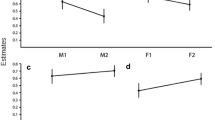Abstract
In a related paper, we showed that mares that reproduced early in life tended to have higher fecundity because of a decrease in the duration of inter-birth intervals relative to mares that reproduced later in life. However, we know that young mares are subordinate to older mares. Hence, costs associated with low dominance rank might offset the benefits of earlier reproduction. We compared harassment of foals of female Jeju ponies that first reproduced at three years of age with that of foals of females that first reproduced at five years of age. As a consequence of their positions in the linear dominance hierarchy, foals born to and guarded by young mares were harassed more frequently than foals whose mothers were older when they first reproduced. A mare that reproduced early in life guarded her offspring more closely and intervened between her foal and neighboring mares more frequently than those mares which first reproduced when older. This need to guard their foals and the harm that might ensue from frequent harassment might counter-balance selection towards earlier reproduction in mares.



Similar content being viewed by others
References
Altmann J (1974) Observational study of behavior: sampling methods. Behaviour 49:227–267
Bell G (1980) The costs of reproduction and their consequences. Anim Behav 31:600–608
Berger J (1986) Wild Horses of the Great Basin. University of Chicago Press, Chicago
Bronmmer JE, Pietiainen H, Kolunen H (1998) The effect of age at first breeding on Ural owl lifetime reproductive success and fitness under cyclic food conditions. J Anim Ecol 67:359–369
Clark MM, Spencer CA, Galef BG (1986) Reproductive lives history correlates of early and late sexual maturation in female Mongolian gerbils (Meriones unguiculatus). Anim Behav 34:551–560
Clutton-Brock TH (1988) Reproductive Success. University of Chicago Press, Chicago
Ensminger ME (1969) Horses and horsemanship, 4th edn. The Interstate, Danvile
Feh C (1999) Alliance and reproductive success in Camargue stallions. Anim Behav 57:705–713
Festa-Blanchet M, Jorgenson JT, Lucherini M, Wishart WD (1995) Life history consequences of variation in age of primiparity in bighorn ewes. Ecology 76:871–881
Green WCH, Rothstein A (1991) Trade-offs between growth and reproduction in female bison. Oecologia 86:521–527
Gross MR, Sargent RC (1985) The evolution of male and female parental care in fishes. Am Zool 25:807–822
Hairstone NG (1983) Growth, survival and reproduction of Plethodon jordani trade-offs between selection pressures. Copeia 4:1024–1035
Kaseda Y, Ashraf MK (1996) Harem size and reproductive success of stallions in Misaki feral horses. Appl Anim Behav Sci 47:163–173
Keiper R, Houpt K (1984) Reproduction in feral horses: An eight-year study. Am J Vet Res 45:991–995
Komers PE, Christophe P, David S (1997) Age at first reproduction in male fallow deer: age-specific versus dominance-specific behaviors. Behav Ecol 8:456–462
Monard MM, Duncan P, Boy V (1996) The proximate mechanisms of natal dispersal in female horses. Behaviour 133:1095–1124
Rho JR, Choe JC (2002) Diurnal activity patterns of Jeju ponies (Equus caballus). Korean J Biol Sci 6:293–299
Rho JR, Srygley RB, Choe JC (2004a) Age-specific fertility rates of the Jeju pony (Equus caballus). J Ethol 22:113–117
Rho JR, Srygley RB, Choe JC (2004b) Behavioral ecology of the Jeju pony (Equus caballus): Effects of maternal age, maternal dominance hierarchy and foal age on mare aggression. Ecol Res 19:55–63
Roff DA (1992) The Evolution of Alternative Mating Strategies. In: Staddon JER (ed) Limits to action. Academic Press, New York, pp 65–100
Rubenstein DI (1982) Reproductive value and behavioral strategies: coming of age in monkeys and horses. Perspect Ethol 5:469–487
Rutberg AT, Greenberg SA (1990) Dominance, aggression frequencies and modes of aggressive competition in feral pony mares. Anim Behav 40:322–331
Setchell JM, Lee PC, Wickings EJ, Dixson FF (2002) Reproductive parameters and maternal investment in Mandrills (Mandrillus sphinx). Int J Primatol 23:51–68
Stearns SC (1992) The evolution of life histories. Oxford University Press, New York
Stevens EF (1990) Instability of harems of feral horses in relation to season and presence of subordinate stallions. Behaviour 112:149–161
Stevenson IR, Bancroft DR (1995) Fluctuating trade-offs favour precocial maturity in male Soay sheep. Proc R Soc Lond B 262:267–275
Tkadlec E, Zejda J (1995) Precocious breeding in female common voles and its relevance to rodent fluctuations. Oikos 73:231–236
Zar JH (1999) Biostatistical analysis, 4th edn. Prentice Hall, Upper Saddle River
Acknowledgments
We are grateful to Katherine A. Houpt, Susan Lappan, and Daniel Mills for comments on the manuscript. We thank the Korean Institute for Livestock Promotion for data on reproduction of the mares on the farm since 1986, and Hong S. Kim, Chang S. Park, and other farm keepers for the care of horses on the farm. We are also very grateful to Hang K. Oh and Jung Y. Song for providing assistance at the start of this study. This study was supported by a BK21 Research Grant from the Korean Ministry of Education and Human Research Development.
Author information
Authors and Affiliations
Corresponding author
About this article
Cite this article
Rho, J.R., Srygley, R.B. & Choe, J.C. Age of the Jeju pony (Equus caballus) at first reproduction: potential costs for foals and mothers that first reproduce early in life. J Ethol 27, 483–488 (2009). https://doi.org/10.1007/s10164-008-0146-4
Received:
Accepted:
Published:
Issue Date:
DOI: https://doi.org/10.1007/s10164-008-0146-4




